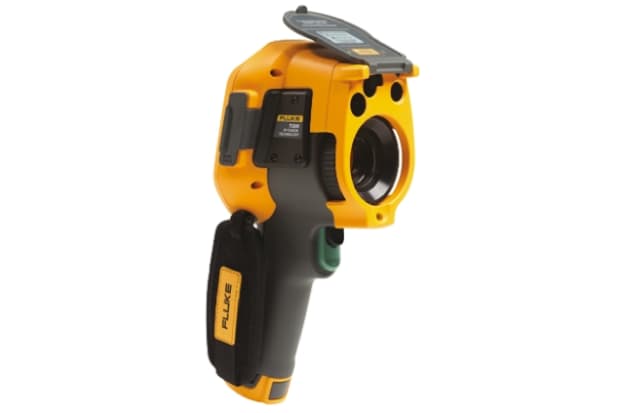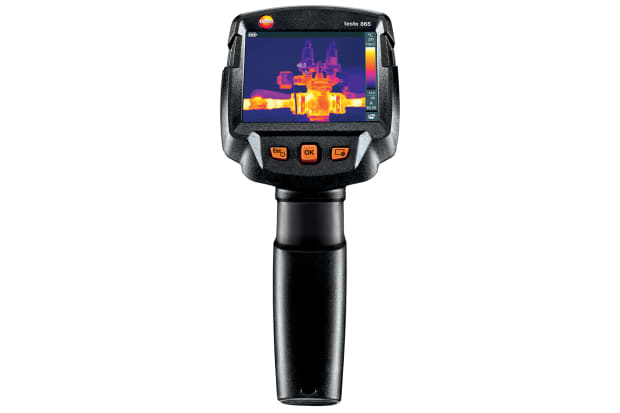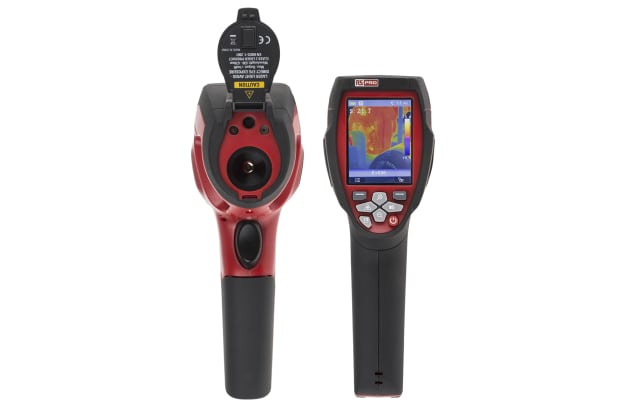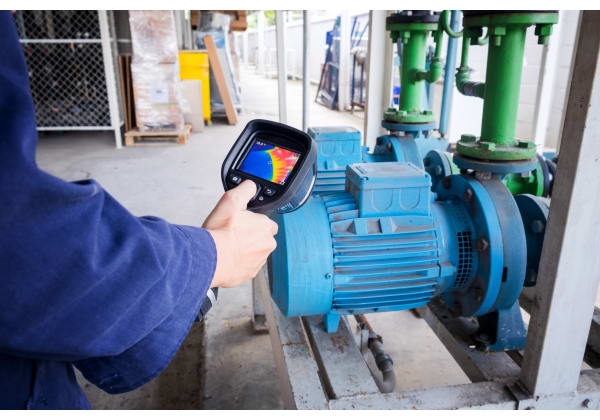- Published 5 Jan 2023
- Last Modified 12 Jun 2024
- 13 min
Everything You Need to Know About Thermal Imaging Cameras
Explore our comprehensive guide to discover the best thermal imaging cameras for your needs. Learn exactly how thermal imaging works to enhance your vision in various applications.

Reviewed by Jay Proctor, Technical Support Team Leader (July 2021)
Thermal imaging is a method of measuring objects' temperatures using infrared light wavelengths. We perceive this as heat and, for that reason, it's also known as infrared thermography.
Thermal imaging cameras are devices typically used to detect infrared light. This guide thoroughly explores thermal imaging cameras, explaining how they work and their common uses.
What is Thermal Imagery?

Thermal imaging is a non-contact technology that converts infrared waves into images that depict temperature. The temperature range of objects in the image is differentiated using a spectrum of colours.
Thermal imaging is an efficient, safe, and easy-to-use non-contact technology. Detecting temperature rises, instabilities, or hot spots in just a few seconds can identify and pinpoint potential failures in equipment or systems before they cause expensive damage, downtime, or power loss. It's invaluable in areas where equipment can't be shut down or easily accessed. It's also useful in situations where physical contact with the object would alter its temperature and skew the results.
Locating hot or cold spots is fast with thermal imaging. The technology helps maintain productivity through rapid diagnosis and measurement without shutting down production equipment or processes.
In addition, enhanced safety comes from measuring temperature from a distance - ideal for eliminating risk in applications that involve moving parts, high levels of heat, or are in dangerous environments.
What are Thermal Imaging Cameras?
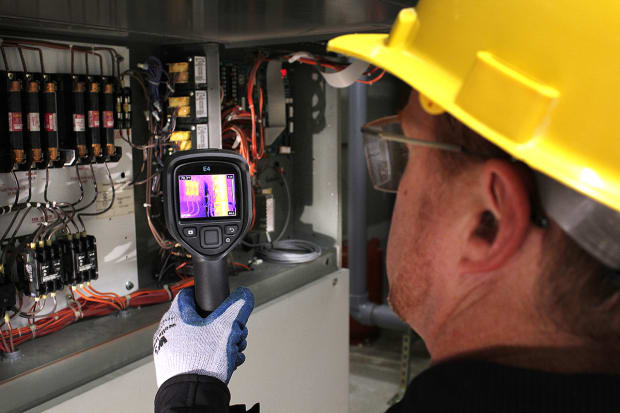
A thermal imaging camera consists of a handheld electronic device featuring an integrated display that detects heat energy.
Thermal cameras are equipped with heat sensors and a special lens that can be used with standard image-capture technology. Engineers can then identify heat sources or areas of excess temperature quickly. Inspecting a building for possible gaps in thermal insulation, for example, or overheating components.
We can only see a small portion of the electromagnetic spectrum - visible light. Sensors on thermal detection cameras allow users to observe the infrared spectrum between visible light and microwaves, which is otherwise invisible.
Modern IR cameras often render this in colour. However, greyscale displays are preferred for some applications because they reduce visual clutter and capture fine detail better.
In a colour display of temperature, warmer areas will be shown in yellows, oranges, and reds, whereas cooler regions will appear in blues and purples. Green indicates room temperature areas. In very dark or obscured environments, thermal cameras can help identify heat sources by detecting infrared radiation rather than visible light.
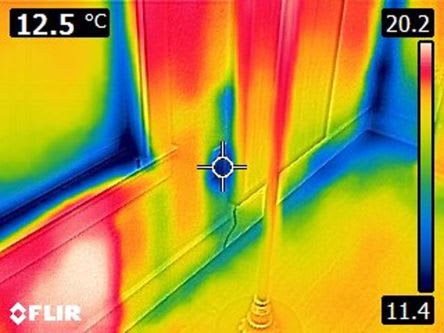
Among the quality thermal imaging cameras available in the UK are those with ergonomically designed user-friendly designs that can detect a broad range of temperatures. Emergency response units, medics, product manufacturers, engineers, and maintenance workers across a wide range of industries benefit from their use.
The History of Thermal Imaging Cameras
As thermographic technology developed, handheld thermal cameras have become more accessible to most applications in recent years. However, it isn't a new concept to view heat as an infrared spectrum.
British-German astronomer William Herschel, who discovered infrared while studying visible light using a prism, established the basic thermography principle in 1800.
As Herschel discovered, it was possible to place a thermometer just beyond the red light end of the spectrum. Using this method, he would be able to detect the presence of an invisible band which is warmer than visible light. Today, this is known as infrared radiation.

While thermal imaging cameras had yet to be developed, Herschel's work led to the creation of thermocouple-type modules whose sensors were able to detect emanating warmth from considerable distances. In the years that followed, other inventors, engineers, and physicists developed his initial discovery.
Technology rapidly progressed towards solid-state thermal imaging arrays during the 1970s, and eventually to hybridised single-crystal imaging devices. In contrast to early mechanical units, handled units developed during the 1980s and '90s were more versatile, easier to use, and did not need active cooling.
A thermal imaging camera is one of the most popular tools in many professional toolkits today.
How Do Infrared Cameras Work?
An infrared camera detects and measures infrared radiation emitted by objects - heat signatures.
IR frequencies are passed through a lens equipped by the camera. This lens focuses IR frequencies on an array of sensors for detection and reading.
Sensor arrays consist of pixels that convert infrared wavelengths into electronic signals by reacting to them. These signals are transmitted to a processor inside the camera's main body. Through the use of algorithms, this processor converts them into a colour map that shows various temperature values. Rendering of this map occurs on the display.
Thermal cameras often have a standard mode for visible light, just like standard digital cameras. The user can then quickly identify specific problem areas once stepping out from behind the lens by comparing the two identical shots taken in IR and normal modes.

Thermal Imaging Camera Usage Questions
Alongside questions about how thermal imaging cameras work in general, there are also common queries regarding specific use scenarios. These primarily concern the effectiveness of the technology in particular environments or applications.
In this section, we’ll examine a few of the better answers and the reasoning behind them.
Why Do Thermal Imaging Cameras Work Better at Night?
Thermal imaging cameras tend to work better at night, but it has nothing to do with the surrounding environment being light or dark.
Rather, because the ambient temperature - and, more importantly, the core temperature of otherwise unheated objects and environments - is nearly always significantly lower at night than during sunlight hours, thermal imaging sensors can display warm areas at higher contrast.
Even on relatively cool days, heat energy from the sun will be gradually absorbed by buildings, roads, vegetation, and construction materials whenever it’s daylight outside. Moreover, every degree that these kinds of objects gain in ambient temperature during the day makes them more difficult to distinguish from other warm objects that the camera's sensor detects.
For the same reason, most thermal imaging cameras will display warm objects in sharp contrast after several hours of darkness, rather than just after the sun sets. Even during full daylight hours, they’ll usually be more effective in the early morning than in the middle of the afternoon.

Do Thermal Cameras Work Through Glass?
You may be surprised to learn that thermal imaging cameras don’t generally work through glass.
A full explanation of the technical reasons for this would be somewhat complex from a physics standpoint, but the principle is pretty straightforward. In essence, a sheet of glass allows visible light through but acts like a mirror at infrared wavelengths (this is why IR cameras have lenses made from germanium or zinc selenide, not glass).
If you pointed a thermal detection camera at a window, what you’d see onscreen wouldn’t be a clear thermal rendering of what’s on the other side. Instead, you'd see a blurry mess - and possibly a vague reflection of yourself holding the camera!
It’s not a hard and fast rule, though; certain infrared frequencies can pass through glass, and certain types and configurations of glass may allow different levels of infrared to pass through. Car windscreens tend to yield better results than standard household glazing, for example.
In most cases though, the image will be largely obscured by infrared reflections from the ‘wrong’ side of the glass, overlaid with varying degrees of opacity. At the very least, the object being viewed will lack significant detail and contrast.
In short, you won’t want to use a thermal imaging camera to get accurate readings through glass (or various other types of highly reflective surfaces).
Do Thermal Cameras Work Underwater?
IR cameras don't work well underwater. The reasons are, in part, related to the glass issues outlined above.
Water blocks infrared wavelengths, similar to an opaque barrier that blocks visible light. Just as we cannot see through paint, infrared sensors cannot detect anything through water because the wavelengths they detect are not capable of passing through it.
Water also provides another challenging issue for IR cameras, related to thermal conductivity and specific heat. Water has a much higher heat capacity than air, requiring four times as much energy to raise or lower the temperature of an equivalent volume by one degree.
In practical terms, this means that objects lose (or gain) their own heat energy relative to water much faster, and over shorter distances. For thermal imaging purposes, objects are therefore naturally more challenging to differentiate when submerged than in the air.
Can Thermal Cameras See Through Walls?
Thermal imaging cameras detect the surface temperature of the first object in their line of sight. By pointing it at a wall or other solid surface, it will measure the heat radiated outward.
Thermographic imaging of an exterior building seldom reveals much about its interior, since most buildings are designed to trap heat. As a caveat, an IR camera could be used to detect extreme heat radiating from behind a wall (for example, during a building fire), since the wall itself would quickly heat up.
How to Improve the Accuracy of Thermal Imaging Camera Readings?
The emissivity settings on a thermal imaging camera can ensure accurate readings. This setting is typically used to improve the accuracy of surface temperature measurement as the wrong setting could give wrong readings.
For non-reflective painted surfaces and non-metals, emissivity is generally 0.95. However, some materials have a different emissivity, so the sensor's emissivity setting should be adjusted to match and fine-tune the measurement accuracy.
Infrared Camera Uses
Thermal imaging requirements differ from application to application and this determines the instrument characteristics needed. However, many camera manufacturers adopt a broader initial split in thermal imaging applications - buildings or industrial.
One of the most familiar uses of thermal detection cameras today is in the emergency services, beyond basic engineering applications. Firefighting, disaster response, and nighttime police pursuits all benefit from the technology.
Nevertheless, thermal imaging cameras have many other applications that may not be immediately apparent. So, what is thermal imaging used for? Here are a few examples:
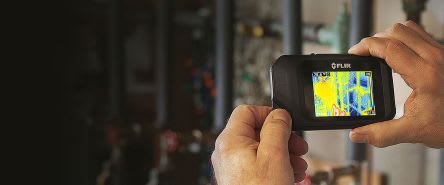
Thermal Cameras for Drones
UAVs and remotely piloted drones often carry thermal imaging sensors, which are very useful in dangerous situations or difficult conditions. For hobbyist drone photographers, thermography is an invaluable asset. UAVs for thermal imaging are also highly beneficial for search and rescue teams, tactical military applications, and emergency response units.
Thermal Cameras for Fire Detection
Ash, fog, dust, and other contaminants can obscure visibility. In these low-visibility situations, thermal imaging helps firefighters locate survivors. In addition, it can pinpoint hotspots, additional ignition sources, or even still-burning fires that might arise from unexpected sources, like underground or inside cavity walls.
Thermal Imaging Cameras for Wildlife
Environmental monitoring, animal tracking, and wildlife photography are all common applications of thermal imaging. In natural habitats, sensor-equipped IR cameras can be left unmanned to trigger automatically when they detect nocturnal or hard-to-see wildlife. In some regions, this makes it feasible to monitor species and behaviour far more comprehensively than was previously possible.
Thermal Imaging Marine Cameras
Thermography can be used in a variety of marine applications. These include enhancing collision detection during night sailing, fog, or severe weather. In spite of the limited effectiveness of underwater thermal imaging (even with the most advanced technologies), heat detection cameras are commonplace on seagoing vessels of all sizes today, manufactured to marine-grade specifications and mounted in multiple positions.
Thermal Security Cameras
The majority of business premises use some form of security camera technology. Indeed, using the best thermal imaging cameras and surveillance equipment to achieve identification, protection, and ROI has become more commonplace in recent years.
Poor visibility and low light situations are well served by thermal security cameras. Additionally, they minimise the visual camouflage that's often found near offices and warehouses, such as dense foliage. Furthermore, CCTV cameras with thermal imaging are often equipped with advanced sensors and analytics, reducing false alarms.
Night Vision Cameras
Although both thermal imaging IR units and standard night vision cameras help increase visibility under low-light or occluded conditions, they’re two separate products that rely on distinct technology.
The key difference is that cameras with night vision rely on just the right level of ambient light present to amplify what minimal light they detect. The sensor can’t cope with excess light, but many people don’t realise that in a completely dark environment, night vision technologies can’t outperform human vision either.
Most night vision cameras are therefore equipped for infrared illumination functionality to provide more amplifiable electromagnetic signals to help the sensor in very murky conditions. These are not visible to the naked eye, but can easily be detected by anyone else using night vision; not a problem in most applications, but not ideal for many military or surveillance uses.
While night vision often provides a more naturalistic image under the right conditions, it’s also significantly less capable of revealing targets obscured by fog, smoke, dust, or camouflage.
Industrial Infrared Cameras
There are many current thermal cameras certified for industrial applications. These cameras have various configurations to meet UK manufacturing standards to suit a range of particularly challenging applications and environments.
Examples include cameras certified to operate in areas with explosive gases (e.g. petrochemicals), underground applications like mining, or around high airborne dust particle concentrations found in industries like grain handling and sugar production.
Industrial thermal imaging instruments are used as process validation tools in electric, electronic, electromechanical, and mechanical engineering applications. These include machine tools, production line components, and manufacturing systems, as well as preventative maintenance applications and scheduled service programmes.
If you’re likely to need certification for industrial infrared camera use, always consult manufacturing guidelines. This will confirm that all relevant standards - such as ATEX and IECEx approval for safe use in Zone 1 explosive atmospheres - have been met.
Thermal Imaging Cameras for Buildings
Instruments designed for use in buildings are typically used to detect issues within the fabric of construction. They're also used for problems obscured from view or hidden behind walls. Applications include checking insulation effectiveness, detecting moisture and leaks, testing underfloor heating systems and central heating appliances, and tracking down leaks in ventilation channels.
Choosing a Thermal Imaging Camera
RS wants to make choosing your thermal imaging camera easy. With so many varieties, designs, and sensitivities available, it’s a must to know exactly what you need before deciding on a specific product. To help you buy the right product, we've put together this handy checklist to ensure your camera is right for you. Key considerations include:
Resolution
The resolution of the thermal imaging sensor determines the quality of the image portrayed. The higher the sensor resolution, the sharper and more accurate a single point will be in the image.
Higher resolutions permit smaller objects to be measured from a greater distance. This factor alone can influence the purchasing decision based on the user's expected operational environment. Detector resolution should not be confused with screen resolution.
Remember: A high-resolution screen can only be as good as the detector resolution.
Data
Users can make instant decisions based on the image shown on the screen. This may be to shut the machine down, schedule preventative maintenance, or even do nothing as all appears fine.
Many instruments store measured data in memory and on removable cards to permit offline storage, analysis, and reporting. Some also add extra functionality like Wi-Fi connectivity to allow direct connections to other devices. Measurement data and visual images can be exported directly to smartphones, tablets, or laptops. This enables timely mobile analysis and reporting, plus easy information sharing via email and other channels.
Sensitivity
Sensitivity represents the smallest temperature difference the infrared sensor can distinguish. Devices with higher thermal sensitivities can detect smaller temperature differences to deliver images with increased accuracy. Measured in milliKelvins (mK), the lower the mK number of a camera, the more sensitive it will be. This means that the camera will detect a broader range of temperature differences and display more colours on its screen.
Temperature Range
Another factor to consider is the instrument's temperature range. Not all applications need a measurement range that covers very high heat levels. Imaging devices offering a wider temperature range will use more expensive sensors.
Popular Brands
Here are some of the most popular brands. Click through to view the full product range.
For more information on any particular heat detection products or further advice and assistance with thermal imaging cameras in general, feel free to contact a member of our expert support team.
Glossary of Thermal Imaging Terminology
Click to expand and read about common thermal imaging terms and vocabulary.
Related Articles
Related links
- Thermal Imaging Cameras
- Fluke Thermal Imaging Camera
- Flir Thermal Imaging Cameras
- FLIR Thermal Imaging Camera Infrared Lens for Use with FLIR Exx Series and T500-Series Cameras
- FLIR Thermal Imaging Camera Infrared Lens for Use with E75 E95
- FLIR E6 Pro Thermal Imaging Camera with WiFi 240 x 180pixel Detector Resolution
- FLIR Thermal Imaging Camera Infrared Lens for Use with E86 And E96 Camera, FLIR E76
- Fluke TiX501 Thermal Imaging Camera 640 x 480pixel Detector Resolution

